
The Fokker D.VII was a German World War I fighter aircraft designed by Reinhold Platz of the Fokker-Flugzeugwerke. Germany produced around 3,300 D.VII aircraft in the second half of 1918. In service with the Luftstreitkräfte, the D.VII quickly proved itself to be a formidable aircraft. The Armistice ending the war specifically required, as the fourth clause of the "Clauses Relating to the Western Front", that Germany was required to surrender all D.VIIs to the Allies. Surviving aircraft saw much service with many countries in the years after World War I.
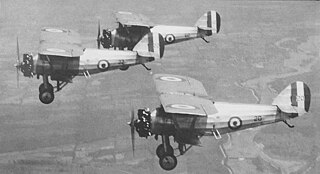
The Armstrong Whitworth Siskin was a sesquiplane single-seat fighter aircraft developed and produced by the British aircraft manufacturer Armstrong Whitworth Aircraft. It was also the first all-metal fighter to be operated by the Royal Air Force (RAF), as well as being one of the first new fighters to enter service following the end of the First World War.
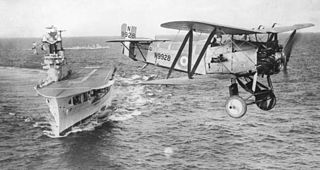
The Fairey Flycatcher was a British single-seat biplane carrier-borne fighter aircraft made by Fairey Aviation Company which served from 1923 to 1934. It was produced with a conventional undercarriage for carrier use, although this could be exchanged for floats for catapult use aboard capital ships.

The Fokker D.XXI fighter was designed in 1935 by Dutch aircraft manufacturer Fokker in response to requirements laid out by the Royal Netherlands East Indies Army Air Force.

The Hawker Woodcock was a British single-seat fighter built by the Hawker Engineering Company as the first fighter to be produced by Hawker Engineering. It was used by the RAF as a night fighter in the 1920s.

Fokker D.XVII, was a 1930s Dutch sesquiplane developed by Fokker. It was the last fabric-covered biplane fighter they developed in a lineage that extended back to the First World War Fokker D.VII.

The Hawker Danecock biplane was developed from the Hawker Woodcock for the Danish air force and naval service.
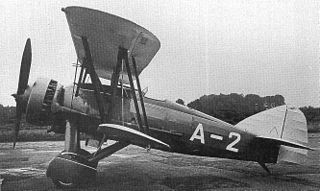
The Armstrong Whitworth A.W.16 was a British single-engine biplane fighter aircraft designed and built by Armstrong Whitworth Aircraft. A number were sold to the Chinese Kwangsi Air Force.

The Armstrong Whitworth A.W.14 Starling was a prototype British single-seat biplane fighter developed for the Royal Air Force in the late 1920s which unsuccessfully competed against the Bristol Bulldog.
The Avro 636 was a single-engined British fighter-trainer built by Avro in the mid-1930s. Four were built for the Irish Air Corps.

The Koolhoven F.K.51 was a 1930s Dutch two-seat basic training biplane built by the Koolhoven Company.

The Fokker C.VII-W was a reconnaissance seaplane built in the Netherlands in the late 1920s. Sharing elements of the highly successful C.V design, the C.VII-W was a conventional, single-bay biplane with wings of unequal span braced with N-struts. The undercarriage consisted of a standard twin-pontoon arrangement, and the fin and rudder continued through to the ventral side of the fuselage, creating a cruciform tail. The pilot and observer sat in tandem, open cockpits. The wing structure was wooden with fabric and plywood covering, and the fuselage was of steel tube construction with fabric covering.

The Fokker S.IV was a military trainer aircraft produced in the Netherlands in the mid-1920s. It was a conventional, single-bay biplane with staggered wings of unequal span braced with N-struts, essentially a radial-engined development of the S.III. The pilot and instructor sat in tandem, open cockpits and the undercarriage was of fixed, tailskid type with a cross-axle between the main units. The Royal Netherlands Army Aviation Group purchased 30 examples and used them right up to the German invasion of the Netherlands in 1940. On 14 May that year, a few surviving S.IVs escaped to France alongside some S.IX trainers, but never flew again.

The Fokker S.IX was a military trainer aircraft produced in the Netherlands in the mid-1930s, designed at a Royal Netherlands Navy request for a machine to replace the obsolete Fokker S.IIIs then in service. It was a conventional, single-bay biplane with staggered wings of unequal span braced with N-struts. The pilot and instructor sat in tandem, open cockpits and the undercarriage was of fixed, tailskid type with divided main units. The wing had a wooden structure, the fuselage one of welded steel tube, and the entire aircraft was fabric-covered.
The Aviatik (Berg) D.II, the prototypes of which were known as Aviatik 30.22 and Aviatik 30.38, was an Austro-Hungarian sesquiplane fighter aircraft prototype towards the end of the First World War.
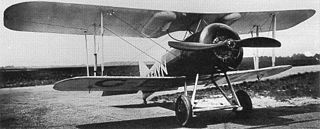
The Gloster Grouse was a British biplane of the 1920s developed by the Gloster Aircraft Company. Often referred to as the prototype to the Gloster Grebe, the Grouse originally built as an experimental aircraft and then later developed as a trainer. Despite its compact design and maneuverability, the Grouse was not in itself a commercial success, although it formed the basis for the Gloster Grebe and Gamecock fighters which were used by Britain's Royal Air Force into the 1930s.
The Blackburn F.1 Turcock was a British single-seat single-engine biplane fighter built in 1927. Designed to be produced in several variants, only one was completed.

The Blackburn R.2 Airedale was a single-engine three-seat monoplane deck-landing aircraft for land and sea reconnaissance, built in the UK in 1924. Only two were built.

The de Havilland DH.56 Hyena was a prototype British army cooperation aircraft of the 1920s. A single-engined biplane, the Hyena was designed against an RAF requirement, but was unsuccessful with only two being built, the Armstrong Whitworth Atlas being preferred.
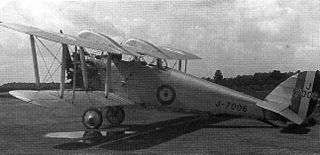
The de Havilland DH.42 Dormouse and its two variants the de Havilland DH.42A Dingo I and II were two-seat single-engined biplanes designed for fighter-reconnaissance and army cooperation roles. They did not achieve production.




















